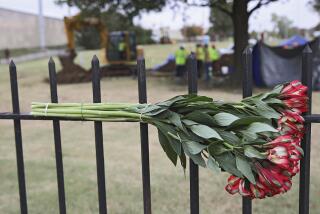Op-Ed: My aunt’s struggle with assisted suicide: There was death, but not enough dignity

My aunt’s journey toward “death with dignity” began last November. The first symptom was difficulty swallowing after a severe cold — nagging, but not too serious. By December, she was complaining that she couldn’t move her left arm and shoulder. And she was tired, tremendously fatigued.
Finally in March, after a battery of tests, the doctor gave her a fatal, hopeless diagnosis — ALS, amyotrophic lateral sclerosis, also known as Lou Gehrig’s disease. My aunt would not get better; instead, each day would be worse than the one before, until eventually she suffocated or slowly starved to death as the muscles in her throat collapsed.
For the record:
5:19 a.m. April 23, 2024An Aug. 14 op-ed about one family’s experience with California’s End of Life Option Act incorrectly called the law the Death with Dignity Act. It also said that a doctor cannot be present when a terminally ill patient takes lethal drugs in accordance with the law. A doctor may be present, although he or she cannot administer the drugs.
She wasn’t afraid to die. She was deeply religious, confident about the afterlife, and she was adamantly against machinery that would prolong her misery — no feeding tubes, no ventilators.
By April she could no longer lift her head. Walking and talking were difficult. The fatigue was relentless. Even the act of sleeping was a challenge. Her sister (my mom), my sister and I, and her best friend tried to encourage her. But for an ALS patient, hope is hard to find.
Early in June, my aunt attempted suicide. At 2 a.m., alone at her home, she tried to slit her wrists. I’m so grateful it did not end for her that way. She managed just a flesh wound. We had a long talk. She didn’t want to wait for the disease to take her on its evil terms. It was time to join her journey.
On June 9, California’s assisted-suicide Death with Dignity Act went into effect, and my aunt declared her intentions in writing the same day. I embarked on a Google search to figure out how the law worked. It was nearly impossible to get clear information, even from doctors.
We would come to learn the law establishes a strict protocol to obtain the life-ending drugs. It takes a minimum of 15 days, and the countdown would start once a primary care doctor attested to my aunt’s mental fitness, her terminal condition, her desire and ability — on her own — to take the medication that would allow her to die. She had to sign a form stating her intentions, with two witnesses, one not related to her. A second doctor had to affirm the diagnosis and her mental fitness.
For days, I fruitlessly contacted everyone I could think of to find a doctor who would start the process. My aunt’s regular physician never returned my phone call. Cooperating with assisted suicide is a physician-by-physician choice, including hospice and palliative care specialists.
By now, my aunt could no longer walk or swallow anything except small cups of water, iced tea and Boost. She was very weak. We moved her to my mother’s house first and then to mine — luckily, as it turned out. When the local hospice doctor arrived, she quickly agreed to start the paperwork — my aunt and I both cried in relief. It was June 22.
We were in a serious race against her symptoms. Each day my aunt could swallow less, making it harder to be certain she could meet the law’s requirement that she ingest the medicine on her own. I literally prayed for guidance in finding doctor number two: “If this is the right thing to do, please help.” The next morning, I found one more doctor to contact. She agreed.
Finally everything was in place, but my aunt had to wait six long days to meet the timeline minimum, after which her doctor could write the prescription.
On July 7, the pharmacy filled the order: a massive dose of barbiturate that does not take into account the size, age, gender or overall health of the patient. The full “cocktail” included two anti-nausea pills, an anti-seizure pill and 100 capsules of Secobarbital. It all had to be ingested within an hour. The drugs cost more than $3,000, and they aren’t covered by insurance.
It was a surreal day. We gathered at my house — everyone who loved my aunt so much they were willing to help her die. She was restless, impatient. We all were. The pharmacy had promised to get the drugs to us by 2:30 p.m. We waited. We called. The package arrived at 5. Thousands of dollars of lethal medication had been handed to an Uber driver to deliver.
It didn’t exactly match the serene scenario I’d pictured — with appropriate music, Bible readings and meaningful conversation.
We set to work. By law, my aunt’s doctor couldn’t be present, but she had given us detailed instructions. The first anti-nausea pill was crushed and poured into the super-sweet simple syrup I’d concocted to help the medicine go down. The anti-seizure pill I placed under my aunt’s tongue.
My attention turned to the kitchen table, where my husband and sister, wearing latex gloves, frantically scraped the powder from 100 capsules with toothpicks, trying to beat the clock. I paced. In 45 minutes, she had to down the second anti-nausea pill, then 15 minutes later, the final cup, her final cup.
The mountain of powder we poured into more sugar syrup created a half-cup of sludge so bitter it literally burned my tongue. And my aunt, who could barely swallow water, had to drink all of it in less than five minutes to “ensure success.”
It didn’t exactly match the serene scenario I’d pictured — with appropriate music, Bible readings and meaningful conversation. My aunt was surrounded with love, but the day was fraught and frightening.
It was all over quickly, though. After maybe two tablespoons of the required 4 ounces of Secobarbital, my aunt went under. I knew she could still hear us so I said, “It’s OK, Auntie, go to the light.” And she did. When we sat back down at the kitchen table, white powder everywhere, we all had to wonder, “Who the hell wrote this law?”
We had been forced to assist in the most bizarre fashion, jumping through seemingly random legal hoops and meeting arbitrary deadlines while my aunt suffered, and finally emptying capsules, making an elixir so vile I cried when I knew she had to drink it. This was death with dignity?
Don’t get me wrong, the new law and its rules are a start, and I’m thankful it was passed by the voters. But I’m also hopeful that those of us who’ve been on the front lines can offer invaluable insight for improving it over time.
I am certain my aunt did the right thing, and I know we were right to help her. As soon as it was over, I felt overwhelming relief for her and deep respect. Her determined pursuit of death on her terms makes her the bravest person I’ve ever known.
Linda Van Zandt is an entrepreneur and a writer in California.
Follow the Opinion section on Twitter @latimesopinionand Facebook
ALSO
Q&A: How California’s aid-in-dying law will work
Why many hospice doctors like me won’t participate in legal physician assisted suicide
Will hospitals reject California’s assisted suicide law?
More to Read
A cure for the common opinion
Get thought-provoking perspectives with our weekly newsletter.
You may occasionally receive promotional content from the Los Angeles Times.






